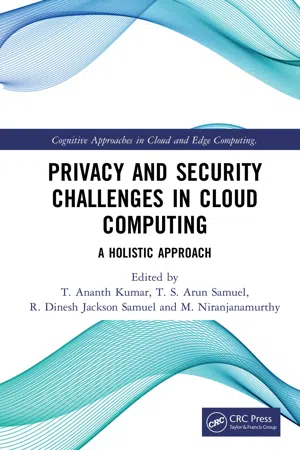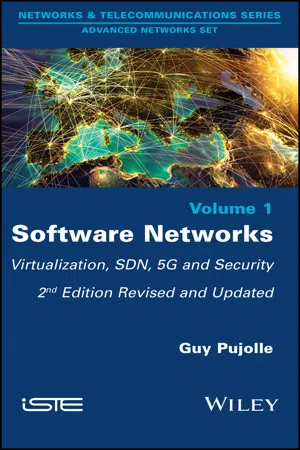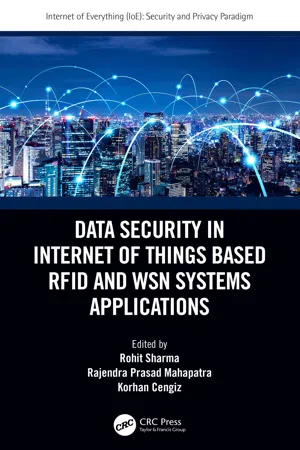Computer Science
Virtual Machines
Virtual machines are software-based emulations of physical computers. They allow multiple operating systems to run on a single physical machine, enabling efficient use of hardware resources. Virtual machines provide a way to isolate and run applications in a contained environment, making them useful for testing, development, and running legacy software.
Written by Perlego with AI-assistance
6 Key excerpts on "Virtual Machines"
Learn about this page
Index pages curate the most relevant extracts from our library of academic textbooks. They’ve been created using an in-house natural language model (NLM), each adding context and meaning to key research topics.
- eBook - ePub
Creating Smart Enterprises
Leveraging Cloud, Big Data, Web, Social Media, Mobile and IoT Technologies
- Vivek Kale(Author)
- 2017(Publication Date)
- Auerbach Publications(Publisher)
The alternative is resource virtualization, a technique analyzed in this chapter. Virtualization is a basic tenet of cloud computing—which simplifies some of the resource management tasks. For instance, the state of a virtual machine (VM) running under a virtual machine monitor (VMM) can be saved and migrated to another server to balance the load. At the same time, virtualization allows users to operate in environments with which they are familiar rather than forcing them to work in idiosyncratic environments. Resource sharing in a virtual machine environment requires not only ample hardware support and, in particular, powerful processors but also architectural support for multi-level control. Indeed, resources such as central processing unit (CPU) cycles, memory, secondary storage, and I/O and communication bandwidth are shared among several Virtual Machines; for each VM, resources must be shared among multiple instances of an application. There are two distinct approaches for virtualization:Full virtualization: Full virtualization is feasible when the hardware abstraction provided by the VMM is an exact replica of the physical hardware. In this case, any operating system running on the hardware will run without modifications under the VMM.Paravirtualization: Paravirtualization requires some modifications of the guest operating systems because the hardware abstraction provided by the VMM does not support all the functions the hardware does.One of the primary reasons that companies have implemented virtualization is to improve the performance and efficiency of processing of a diverse mix of workloads. Rather than assigning a dedicated set of physical resources to each set of tasks, a pooled set of virtual resources can be quickly allocated as needed across all workloads. Reliance on the pool of virtual resources allows companies to improve latency. This increase in service delivery speed and efficiency is a function of the distributed nature of virtualized environments and helps to improve overall time-to-realize value. Using a distributed set of physical resources, such as servers, in a more flexible and efficient way delivers significant benefits in terms of cost savings and improvements in productivity: - eBook - ePub
- Andrew Josey(Author)
- 2020(Publication Date)
- Van Haren Publishing(Publisher)
In the simplest form of virtualization, a specialized application, known as a hypervisor, is loaded like any other application. The purpose of this hypervisor is to emulate the hardware computer in software. Once the hypervisor is running, it can emulate any number of “virtual” computers, each of which can have its own OS.Figure 10. Virtualization is Computers within a ComputerA virtual machine provides an abstract machine that uses device drivers to target the abstract machine, while a container provides an abstract OS. There are two types of “hypervisor”:• Type 1: the hypervisor runs on the host directly (it is also the OS)• Type 2: the hypervisor runs on top of the host’s OSAnother type of virtualization is called “paravirtualization”; a core OS can abstract hardware resources for multiple virtual guest environments without having to virtualize hardware for each guest.Figure 11. Virtualization TypesWhy is Virtualization Important? Virtualization attracted business attention as a means to consolidate computing workloads.For years, companies would purchase servers to run applications of various sizes, and in many cases the computers were badly underutilized. Because of configuration issues and (arguably) an overabundance of caution, average utilization in a pre-virtualization data center might average 10-20%. That’s up to 90% of the computer’s capacity being wasted.Efficiency through Virtualization(Syllabus Reference: Unit 2, Learning Outcome LO-virt-econ: You should be able to explain why virtualization is economically attractive in some cases )In most virtualized architectures:• Physical servers supporting workloads share a consistent configuration, which makes it easy to add and remove resources from the environment• Virtual Machines are easier to manage, they can be easily moved or copied, and can be defined as a “form of code” (aka “Infrastructure as Code”)Virtualization has thus introduced a design pattern into the enterprise where computing and storage infrastructure became commoditized building blocks supporting an ever-increasing array of services. But what about where the application is large and virtualization is mostly overhead? Virtualization still may make sense in terms of management consistency and ease of system recovery. - eBook - ePub
Encyclopedia of Computer Science and Technology
Volume 14 - Very Large Data Base Systems to Zero-Memory and Markov Information Source
- Jack Belzer, Albert G. Holzman, Allen Kent(Authors)
- 2021(Publication Date)
- CRC Press(Publisher)
Virtual Machines provide many advantages to system programmers as well as to normal users of computer systems. Systems programmers have typically been forced to do their work during the middle of the night or at some other nonprime time. On a VM system, however, much system work can be done concurrently with the execution of the normal production workload. This includes the testing and development of systems software as well as the execution of maintenance and diagnostic procedures.VM systems support the concurrent execution of more than one operating system on the same machine. This is extremely valuable in an environment where several different operating systems are supported and used. VM systems can also provide increased security and reliability.Some machines have been shown to be nonvirtualizable. Research is currently being done to formally identify the necessary conditions for the virtualization of given architectures.Virtual machine monitors provide a very powerful extension to a bare machine interface. Groups of users may be utilizing different operating systems concurrently. As long as the suppliers of operating systems software continue to release evolutionary versions of a particular operating system or release a family of operating systems for a given series of machines, the user will be potentially caught in a "vested interest" dilemma. That is, a large number of application programs may have been written which in some obvious or subtle way depend on or take advantage of the operating system on which the code was developed and executes. Thus it may be extremely costly to move these programs "up to" or "down to" an alternative operating system. It is in this context that virtual machine monitors appear to be viable. The user can postpone or complete elementary reprogramming courses at the expense of a run time performance penalty. Virtual machine monitors provide isolated - eBook - ePub
Privacy and Security Challenges in Cloud Computing
A Holistic Approach
- T. Ananth Kumar, T. S. Arun Samuel, R. Dinesh Jackson Samuel, M. Niranjanamurthy, T. Ananth Kumar, T. S. Arun Samuel, R. Dinesh Jackson Samuel, M. Niranjanamurthy(Authors)
- 2022(Publication Date)
- CRC Press(Publisher)
The virtual machine (VM) execution is assessed dependent on its information recovery across the stage, security arrangements, and checking measure. Notwithstanding, this audit chapter is an after-effect of the overview of 60 examination articles that were distributed in the main worldwide diaries. The goal of this survey is to investigate the virtualization world from the authors’ eyes. Also, this chapter aims to provide a critical understanding of what already exists in virtualization, what needs to be done in virtualization, and the implementation of virtualization environments [ 2 ]. 5.2.1 F ULL V IRTUALIZATION Full virtualization is a sort of virtualization which is utilized to give a VME that completely reestablishes the equipment hidden it. Any program equipped for executing on the actual equipment can be run on the VM in this kind of climate, and any operating system upheld by the fundamental equipment can be run on every individual VM. Clients can run a few separate operating systems simultaneously. The VM stimulates sufficient hardware in full virtualization, which permits an unmodified operating system that can be run in segregation. In a variety of cases, this is particularly helpful. For example, they are running a test new code in operating system improvement simultaneously as more established variants, each on an alternate VM. VM can be furnished by the hypervisor with all machine assets, along with virtual profiles, virtual gadgets, and the executive virtualized memory. Guest OS is completely disengaged by the virtualization layer from the underlying hardware [ 3 ]. By utilizing a blend of twofold interpretation and direct execution, complete virtualization is accomplished. The actual central processor executes sensitive directions at local speed with complete virtualization hypervisors. Operating system directions can be deciphered on the ground and put away throughout time, and client-level guidelines run unlimited at local speed - eBook - ePub
Software Networks
Virtualization, SDN, 5G, and Security
- Guy Pujolle(Author)
- 2020(Publication Date)
- Wiley-ISTE(Publisher)
1.6. ConclusionVirtualization is the fundamental property of the new generation of networks, where we make the move from hardware to software. While there is a noticeable reduction in performance at the start, it is compensated by more powerful, less costly physical machines. Nonetheless, the opposite move to virtualization is crucial: that of concretization, i.e. enabling the software to be executed on reconfigurable machines so that the properties of the software are retained and top-of-the-range performances can again be achieved.Software networks form the backbone of the new means of data transport. They are agile, simple to implement and not costly. They can be modified or changed at will. Virtualization also enables us to uncouple functions and to use shared machines to host algorithms, which offers substantial savings in terms of resources and of qualified personnel. - Rohit Sharma, Rajendra Prasad Mahapatra, Korhan Cengiz, Rohit Sharma, Rajendra Prasad Mahapatra, Korhan Cengiz(Authors)
- 2020(Publication Date)
- CRC Press(Publisher)
VM migration helps in better resource utilization and increases cloud providers' capital income. Live VM migration provides uninterrupted cloud services during migration time without compromising service-level agreement (SLA) [ 1 ] violations and achieves efficient resource utilization. Live VM migration is a practical approach in cloud computing. It has various leverages such as load [ 2 ] balancing and helps in energy reduction, better service availability, and so on. 8.1.1 V IRTUALIZATION Virtualization is an elemental technology with the help of which one can take advantage of infrastructure-based services. It creates a protected, estimable, and segregated [ 1 ] environment for the execution of cloud applications. This technology provides the capability to a computer system to imitate the executing environment independent from the computer system itself. It is contemplation of computer resources. It allows separation of the computer operating system from its hardware. It allows a single hardware resource to act as numerous virtual resources [ 3 ] and also various hardware resources to act as a single virtual resource. It has changed the IT world in many ways. It provides increased performance in the high-end side of the computer market where supercomputers give boundless compute power that helps in furnishing thousands of VMs. When there is a lack of space to accommodate thousands of physical machines, then virtualization benefits. Also, it provides the extra computing power needed by large-scale applications. This chapter is constituted as follows. Section 8.2 gives an outline of the literature work. The VM migration mechanism is explained in Section 8.3. The various VM migration techniques used in cloud computing are provided in Section 8.4, which is followed by a conclusion in Section 8.5. 8.2 L ITERATURE W ORK Numerous research articles have been published pertaining to different techniques of VM migration in cloud computing





